Information injection-pump assembly
BOSCH
9 400 611 748
9400611748
ZEXEL
101606-0141
1016060141
ISUZU
8976000812
8976000812
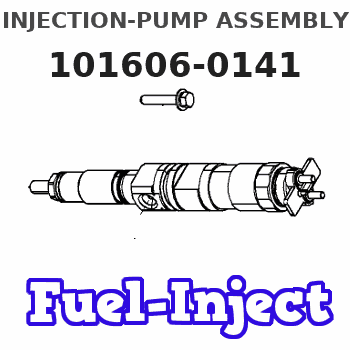
Rating:
Service parts 101606-0141 INJECTION-PUMP ASSEMBLY:
1.
_
7.
COUPLING PLATE
8.
_
9.
_
11.
Nozzle and Holder
8-94391-291-4
12.
Open Pre:MPa(Kqf/cm2)
16.2{165}/19.6{200}
14.
NOZZLE
Include in #1:
101606-0141
as INJECTION-PUMP ASSEMBLY
Include in #2:
104742-1480
as _
Cross reference number
BOSCH
9 400 611 748
9400611748
ZEXEL
101606-0141
1016060141
ISUZU
8976000812
8976000812
Zexel num
Bosch num
Firm num
Name
9 400 611 748
8976000812 ISUZU
INJECTION-PUMP ASSEMBLY
6HL1-N * K 14BF PE6AD PE
6HL1-N * K 14BF PE6AD PE
Calibration Data:
Adjustment conditions
Test oil
1404 Test oil ISO4113 or {SAEJ967d}
1404 Test oil ISO4113 or {SAEJ967d}
Test oil temperature
degC
40
40
45
Nozzle and nozzle holder
105780-8260
Bosch type code
9 430 610 133
Nozzle
105780-0120
Bosch type code
1 688 901 990
Nozzle holder
105780-2190
Opening pressure
MPa
18
Opening pressure
kgf/cm2
184
Injection pipe
Outer diameter - inner diameter - length (mm) mm 6-2-600
Outer diameter - inner diameter - length (mm) mm 6-2-600
Overflow valve
131424-8620
Overflow valve opening pressure
kPa
206
172
240
Overflow valve opening pressure
kgf/cm2
2.1
1.75
2.45
Tester oil delivery pressure
kPa
255
255
255
Tester oil delivery pressure
kgf/cm2
2.6
2.6
2.6
Direction of rotation (viewed from drive side)
Left L
Left L
Injection timing adjustment
Direction of rotation (viewed from drive side)
Left L
Left L
Injection order
1-5-3-6-
2-4
Pre-stroke
mm
3.8
3.75
3.85
Rack position
Point A R=A
Point A R=A
Beginning of injection position
Governor side NO.1
Governor side NO.1
Difference between angles 1
Cal 1-5 deg. 60 59.5 60.5
Cal 1-5 deg. 60 59.5 60.5
Difference between angles 2
Cal 1-3 deg. 120 119.5 120.5
Cal 1-3 deg. 120 119.5 120.5
Difference between angles 3
Cal 1-6 deg. 180 179.5 180.5
Cal 1-6 deg. 180 179.5 180.5
Difference between angles 4
Cyl.1-2 deg. 240 239.5 240.5
Cyl.1-2 deg. 240 239.5 240.5
Difference between angles 5
Cal 1-4 deg. 300 299.5 300.5
Cal 1-4 deg. 300 299.5 300.5
Injection quantity adjustment
Adjusting point
-
Rack position
14.5
Pump speed
r/min
850
850
850
Average injection quantity
mm3/st.
133.5
131.9
135.1
Max. variation between cylinders
%
0
-2.5
2.5
Basic
*
Fixing the rack
*
Standard for adjustment of the maximum variation between cylinders
*
Injection quantity adjustment_02
Adjusting point
Z
Rack position
9.5+-0.5
Pump speed
r/min
300
300
300
Average injection quantity
mm3/st.
15.5
14.2
16.8
Max. variation between cylinders
%
0
-14
14
Fixing the rack
*
Standard for adjustment of the maximum variation between cylinders
*
Injection quantity adjustment_03
Adjusting point
A
Rack position
R1(14.5)
Pump speed
r/min
850
850
850
Average injection quantity
mm3/st.
133.5
132.5
134.5
Basic
*
Fixing the lever
*
Injection quantity adjustment_04
Adjusting point
B
Rack position
(R1+0.85
)+0.05-0
.15
Pump speed
r/min
1450
1450
1450
Average injection quantity
mm3/st.
127.5
124.3
130.7
Fixing the lever
*
Test data Ex:
Governor adjustment
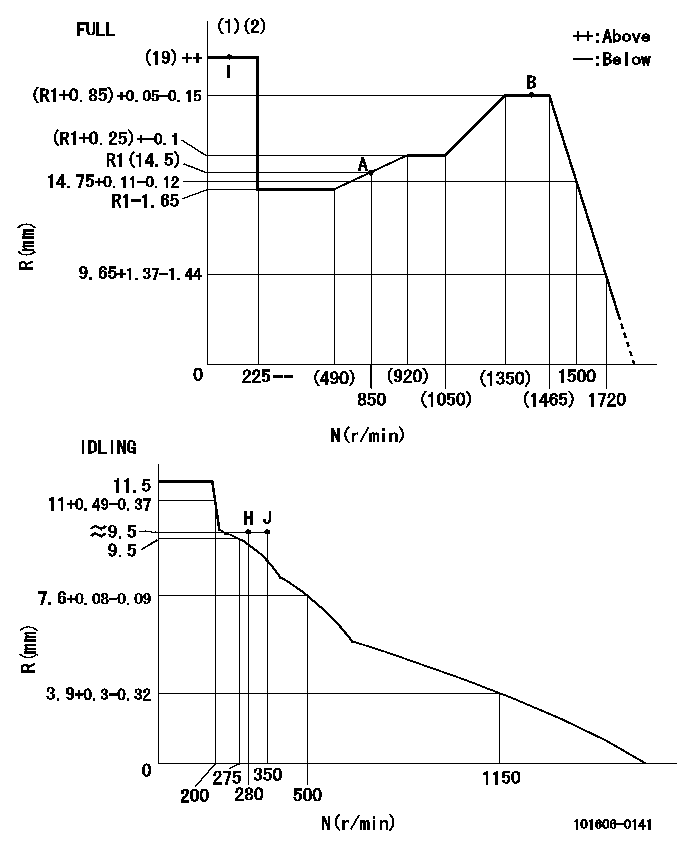
N:Pump speed
R:Rack position (mm)
(1)Torque cam stamping: T1
(2)Tolerance for racks not indicated: +-0.05mm.
----------
T1=P02
----------
----------
T1=P02
----------
Timer adjustment
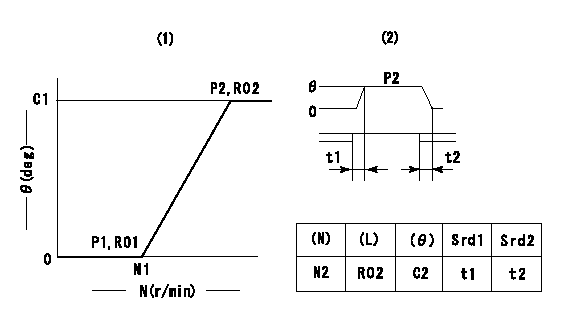
(1)Adjusting range
(2)Step response time
(N): Speed of the pump
(L): Load
(theta) Advance angle
(Srd1) Step response time 1
(Srd2) Step response time 2
1. Adjusting conditions for the variable timer
(1)Adjust the clearance between the pickup and the protrusion to L.
----------
L=1.5+-0.2mm N2=800r/min C2=(8)deg t1=2--sec. t2=2--sec.
----------
N1=1300++r/min P1=0kPa(0kgf/cm2) P2=392kPa(4kgf/cm2) C1=8+-0.3deg R01=0/4load R02=4/4load
----------
L=1.5+-0.2mm N2=800r/min C2=(8)deg t1=2--sec. t2=2--sec.
----------
N1=1300++r/min P1=0kPa(0kgf/cm2) P2=392kPa(4kgf/cm2) C1=8+-0.3deg R01=0/4load R02=4/4load
Speed control lever angle
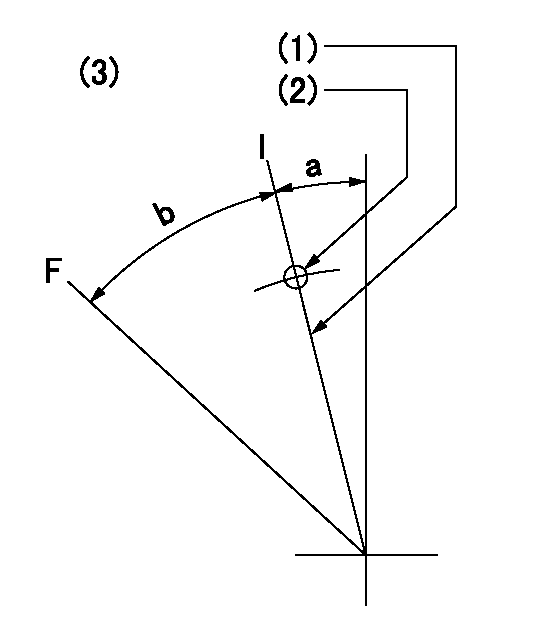
F:Full speed
I:Idle
(1)Stopper bolt set position 'H'
(2)Use the pin at R = aa
(3)Viewed from feed pump side.
----------
aa=35mm
----------
a=10deg+-5deg b=41deg+-3deg
----------
aa=35mm
----------
a=10deg+-5deg b=41deg+-3deg
Stop lever angle
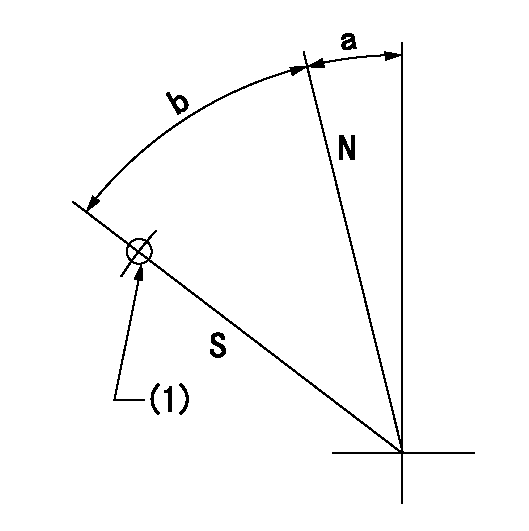
N:Pump normal
S:Stop the pump.
(1)Use the pin at R = aa
----------
aa=45mm
----------
a=12.5deg+-5deg b=40deg+-5deg
----------
aa=45mm
----------
a=12.5deg+-5deg b=40deg+-5deg
0000001501 RACK SENSOR
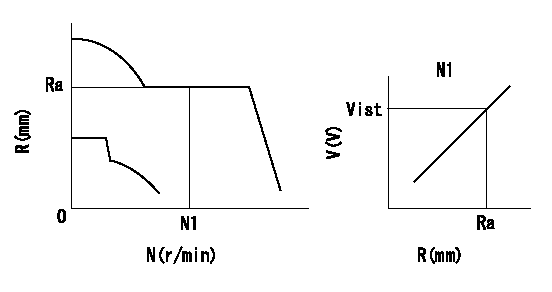
Rack sensor adjustment
1. Flange type rack sensor (rack sensor adjustment -5*20)
(1)These types of rack sensors do not need adjustment. Confirm the performance with the following procedures.
(2)Mount the rack sensor main body to the pump main body.
(3)Fix the pump lever at full.
(4)At supply voltage V1, pump speed N1 and rack position Ra, confirm that the amp's output voltage is Vist.
(5)Move the pump lever two or three times.
(6)Set again to full.
(7)Confirm that the amplifier output voltage is Vist.
(8)Fix the caution plate to the upper part of the rack sensor.
(For those without the caution plate instructions, make sure the nameplate of the rack sensor carries the "Don't hold here" caution.)
(9)Apply red paint to the rack sensor mounting bolts (2 places).
----------
V1=5+-0.01V N1=850r/min Ra=R1(14.5)mm Vist=3.74+-0.28V
----------
----------
V1=5+-0.01V N1=850r/min Ra=R1(14.5)mm Vist=3.74+-0.28V
----------
Timing setting
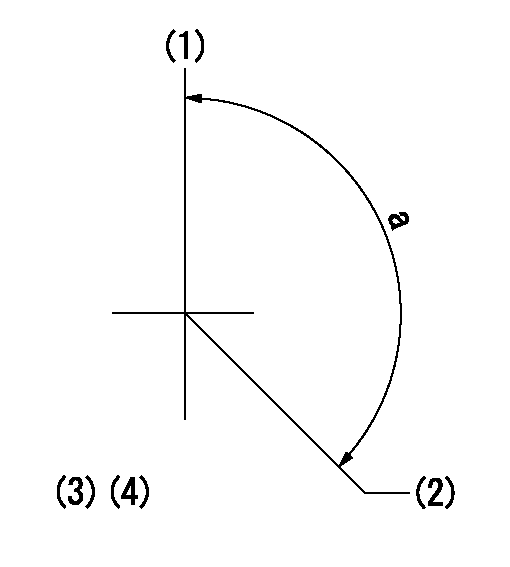
(1)Pump vertical direction
(2)Positions of coupling's threaded installation holes at No 1 cylinder's beginning of injection
(3)B.T.D.C.: aa
(4)-
----------
aa=6deg
----------
a=(160deg)
----------
aa=6deg
----------
a=(160deg)
Information:
Radiator Fins, Aftercooler,Belts, and Hoses
Inspect/Check Radiator Fins
Check the radiator fins for debris. High pressure water is an excellent way to clean the debris out of the radiator fins. If necessary, use a light bulb behind the radiator fins to see if they are completely clean.Refer to Know Your Cooling System, SEBD0518, for more detailed information on cleaning your radiator fins.Inspect/Check Aftercooler System
A hose failure or significant system leak will cause a large drop in boost pressure and power. The engine can be operated at this power level long enough to reach a safe stop or repair area. Sustained operation under this condition should be avoided.
Inspect the front of the air-to-air aftercooler. Examine core fins for external damage, insects, dirt, debris, salt, corrosion, etc. Use a firm stainless steel brush and soapy water to remove dirt, debris, salt, etc. Depending on your findings and operating environment, the maintenance interval for cleaning the air-to-air aftercooler may be more frequent.A slight reduction in power or response, or a small increase in exhaust temperature, may indicate a small air leak in the charge air cooler core or piping. Inspect all air ducting and gasket connections at each oil change. Constant torque hose clamps should be secure. Tighten these clamps until the spring is at least partially compressed.Inspect all welds for cracks. Check the mounting brackets to ensure they are secure and in good condition. Whenever air-to-air aftercooler parts are repaired and/or replaced, a leak test is highly recommended. Refer to the service manual or consult your Caterpillar dealer for the correct procedure to use when performing a leak test.Inspect/Adjust Belts
Inspect the condition and adjustment of alternator belts and fan drive belts.Inspect all drive belts for wear and replace if they show any signs of wear.If one belt in a set requires replacement, always install a new matched set of belts. Never replace just the worn belt. If only the worn belt is replaced, the new belt will carry all the load, as it will not be stretched as much as the older belts. All the belts will fail in rapid succession.If belts are too loose, they vibrate enough to cause unnecessary wear on the belts and pulleys. If belts are too tight, unnecessary stresses are placed upon the pulley bearings and belts which might shorten the life of both.1. Inspect the condition and adjustment of alternator belts and fan drive belts.2. To check the belt tension, apply 110 N (25 lbs) of force midway between the pulleys. Correctly adjusted belts will deflect 13 to 19 mm (1/2 to 3/4 inch).Adjust Alternator Belts
3. To adjust the alternator drive
Inspect/Check Radiator Fins
Check the radiator fins for debris. High pressure water is an excellent way to clean the debris out of the radiator fins. If necessary, use a light bulb behind the radiator fins to see if they are completely clean.Refer to Know Your Cooling System, SEBD0518, for more detailed information on cleaning your radiator fins.Inspect/Check Aftercooler System
A hose failure or significant system leak will cause a large drop in boost pressure and power. The engine can be operated at this power level long enough to reach a safe stop or repair area. Sustained operation under this condition should be avoided.
Inspect the front of the air-to-air aftercooler. Examine core fins for external damage, insects, dirt, debris, salt, corrosion, etc. Use a firm stainless steel brush and soapy water to remove dirt, debris, salt, etc. Depending on your findings and operating environment, the maintenance interval for cleaning the air-to-air aftercooler may be more frequent.A slight reduction in power or response, or a small increase in exhaust temperature, may indicate a small air leak in the charge air cooler core or piping. Inspect all air ducting and gasket connections at each oil change. Constant torque hose clamps should be secure. Tighten these clamps until the spring is at least partially compressed.Inspect all welds for cracks. Check the mounting brackets to ensure they are secure and in good condition. Whenever air-to-air aftercooler parts are repaired and/or replaced, a leak test is highly recommended. Refer to the service manual or consult your Caterpillar dealer for the correct procedure to use when performing a leak test.Inspect/Adjust Belts
Inspect the condition and adjustment of alternator belts and fan drive belts.Inspect all drive belts for wear and replace if they show any signs of wear.If one belt in a set requires replacement, always install a new matched set of belts. Never replace just the worn belt. If only the worn belt is replaced, the new belt will carry all the load, as it will not be stretched as much as the older belts. All the belts will fail in rapid succession.If belts are too loose, they vibrate enough to cause unnecessary wear on the belts and pulleys. If belts are too tight, unnecessary stresses are placed upon the pulley bearings and belts which might shorten the life of both.1. Inspect the condition and adjustment of alternator belts and fan drive belts.2. To check the belt tension, apply 110 N (25 lbs) of force midway between the pulleys. Correctly adjusted belts will deflect 13 to 19 mm (1/2 to 3/4 inch).Adjust Alternator Belts
3. To adjust the alternator drive